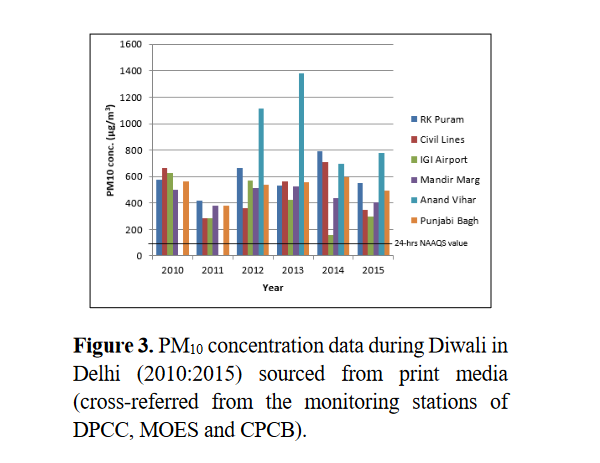Study on air pollution trends (2010-2015) due to fireworks during Diwali festival in Delhi, India
Keywords:
Fireworks, Diwali, Aerosols, Criteria pollutants, NAAQS.Abstract
The burning of massive amount of fire crackers on the evening(s) of a nation-wide celebrated festival called ‘Diwali’ in India, gives rise to a remarkably high concentration of criteria air pollutants and it is of utmost importance to investigate the impact of such high loads originated during a relatively shorter time span in a mega-city like Delhi where the situation of ambient air quality has already been alarming almost through-out the year. In view of the same, the present study analyzes available concentration data during this festival’s night for five criteria pollutants namely PM10 , PM2.5 , SO2 , NO2 , and CO (Particulate Matter, Sulfur Dioxide, Nitrogen Dioxide and Carbon Monoxide respectively) along with NH3 at six key locations of Delhi. Following the analysis, PM10
concentration in Anand Vihar during nighttime of Diwali was reported to be ~8 times higher than the 24 hours values prescribed by National Ambient Air Quality Standards (NAAQS). On the other hand, the same at IGI airport was recorded lowest even though about 3.5 times that of the guiding standard. PM2.5 concentrations were reported as highest and lowest at RK Puram and Civil lines respectively, in both the cases quite exceeding the comparable standard values. Interestingly, remaining criteria pollutants, namely, SO2 , NO2 and CO along with NH3 measured in 2015 showed no values in excess of corresponding 24-hrs guidelines, thereby reporting a better scenario compared to previous years. Further, the extensive use of firecrackers during Diwali festival leads to substantial increase in air pollutants necessitating special measures to control.
References
Barman, S. C., Singh, R., Negi, M. P., & Bhargava, S. K. (2009). Fine particles (PM2.5 ) in ambient air of Lucknow City due to fireworks on Diwali festival. Journal of Environmental Biology, 30(5), 625–632.
Kong, S. F., Li, L., Li, X. X., Yin, Y., Chen, K., Liu, D. T., ... Ji, Y. Q. (2015). The impacts of firework burning at the Chinese spring festival
on air quality: insights of tracers, source evolution and aging processes. Atmospheric Chemistry and Physics, 15(4), 2167–2184.
Vecchi, R., Bernardoni, V., Cricchio, D., D’Alessandro, A., Fermo, P., Lucarelli, F.,...Valli, G. (2008). The impact of fireworks on
airborne particles. Atmospheric Environments , 42(6), 1121–1132.
Drewnick, F., Hings, S.S., Curtius, J., Eerdekens, G., & Williams, J. (2006). Measurement of fine particulate and gas-phase species during the new year’s fireworks 2005 in Mainz, Germany. Atmospheric Environments, 40(23), 4316–4327.
Wang, Y., Zhuang, G., Xu, C., & An, Z. (2007). The air pollution caused by the burning of fireworks during the lantern festival in Beijing, China. Atmospheric Environments, 41(2), 417–431.
Moreno, T., Querol, X., Alastuey, A., Minguillon, M. C., Pey, J., Rodriguez, S.,...Gibbons, C. (2007). Recreational atmospheric pollution
episodes: inhalable metalliferous particles from firework displays. Atmospheric Environments,41(5), 913–922.
Khaparde, V. Pipalatkar, P., Pustode, T., Chalapati, Rao, C. V., & Gajghate, D. (2012). Influence of burning of fireworks on particle size
distribution of PM10 and associated barium at Nagpur. Environmental Monitoring and Assessment, 184(2), 903–911.
Chatterjee, A, Sarkar, C., Adak, A., Mukherjee, U.,Ghosh, S. K., & Raha, S. (2013). Ambient air quality during Diwali festival over Kolkata – A mega-city in India. Aerosol and Air Quality Research, 13(13), 1133–1144.
Ravindra, K., Mor, S., & Kaushik, C. P. (2003). Short-term variation in air quality associated with firework events: a case study. Journal of
Environmental Monitoring, 5(2), 260–264.
Thakur, B., Chakraborty, S., Debsarkar, A., Chakraborty, S., & Srivastava, R. C. (2010). Air pollution from fireworks during festival of
lights (Deepawali) in Howrah, India - a case study. Atmosfera, 23(4), 347–365.
Kulshrestha, U. C., NageswaraRao, T., Azhaguvel, S., & Kulshrestha, M. J. (2004). Emissions and accumulation of metals in the atmosphere due to crackers and sparkles during Diwali festival in India. Atmospheric Environments, 38(27),4421–4425.
Barman, S. C., Singh, R., Negi, M. P. S., & Bhargava, S. K. (2008). Ambient air quality of Lucknow City (India) during use of fireworks
on Diwali festival. Environmental Monitoring and Assessment, 137(1-3), 495–504.
Barman, S. C., Singh, R., Negi, M. P. S., & Bhargava, S. K. (2008b). Fine particles (PM2.5 ) in residential areas of Lucknow city and factors
influencing the concentration. Clean-Soil Air Water, 36(1), 111–117.
Ganguly, N. D. (2009). Surface ozone pollution during the festival of Diwali, New Delhi, India. Earth Science (India), 2(IV), 224–229.
Attri, A. K., Kumar, U., & Jain, V. K. (2001).Formation of ozone by fireworks. Nature, 411(6841), 1015.
WHO. (2003). Health Aspects of Air Pollution with Particulate Matter, Ozone and NitrogenDioxide, Available on WHO website, Bonn,
Germany.
Clark, H. (1997). Air pollution from fireworks.Atmospheric Environment, 31, 2893–2894.
Hirai, K., Yamazaki, Y., Okada, K., Furuta, S.,& Kubo, K. (2000). Acute eosinophilic pneumonia associated with smoke from fireworks. Internal Medicine (Japan), 39(5),401–403.
Dockery, D. W., Luttnabb-Gibson, H., Rich, D. Q.,Link, M. L., Mittleman M. A., Gold, D. R.,...Verrier R. L. (2005). Association of air
pollution with increased incidence of ventricular tachyarrythmias recorded by implanted cardioverter defibrillators.
Environmental Health Perspectives., 113(6),670–674.
Barnett, A. G., Williams, G. M., Schwartz, J., Nekker, A. H., Best, T. L., & Petriescgevsjt, A. L. (2005). Air pollution and child respiratory
health: a case-crossover study in Australia and New Zealand. American Journal of Respiratory and Critical Care Medicine, 171(11), 1272–
Directorate of Economics & Statistics Government of NCT of Delhi. (2015). Delhi statistical handbook. Retrieved December 15, 2015 from
http://admin.indiaenvironmentportal.org.in/files/file/delhi%20statistical%20handbook%202017.pdf
Planning Department Government of NCT of Delhi. (2015). Economic survey of Delhi. Retrieved December 15, 2015 from
http://delhiplanning.nic.in/economic-survey-of-delhi/planning-department













